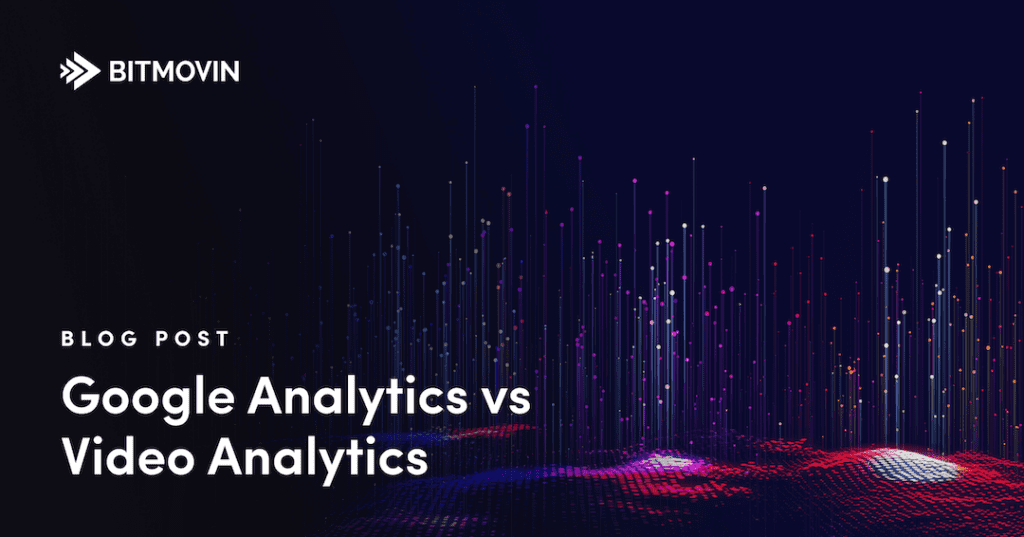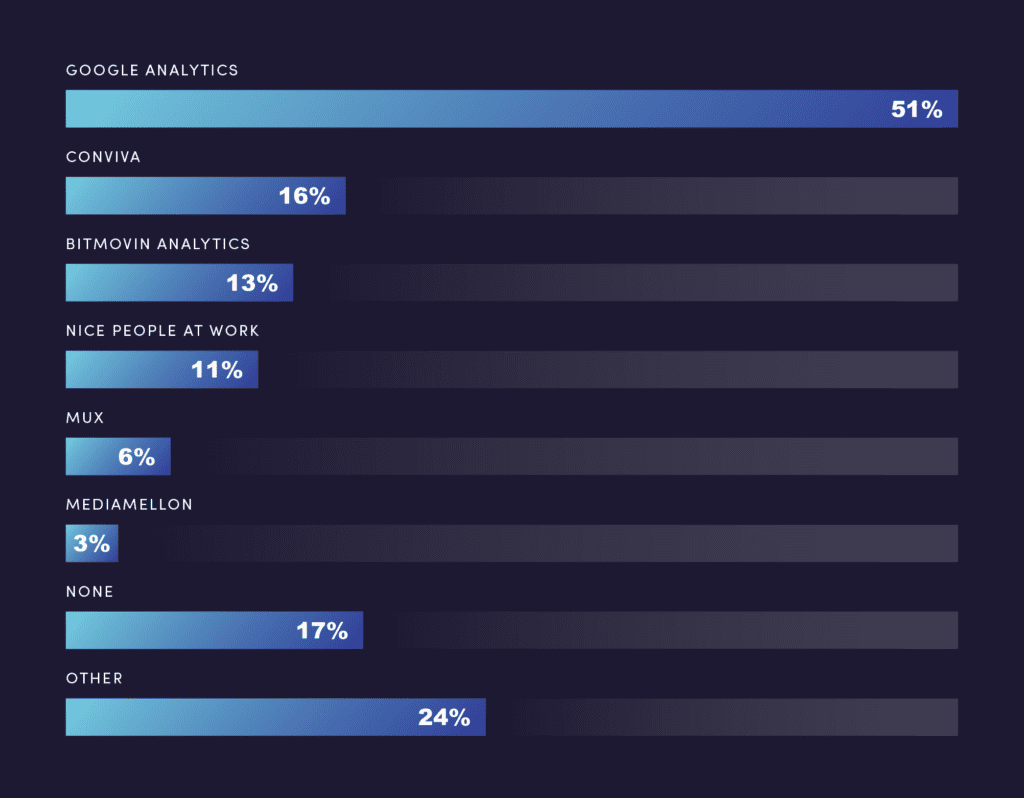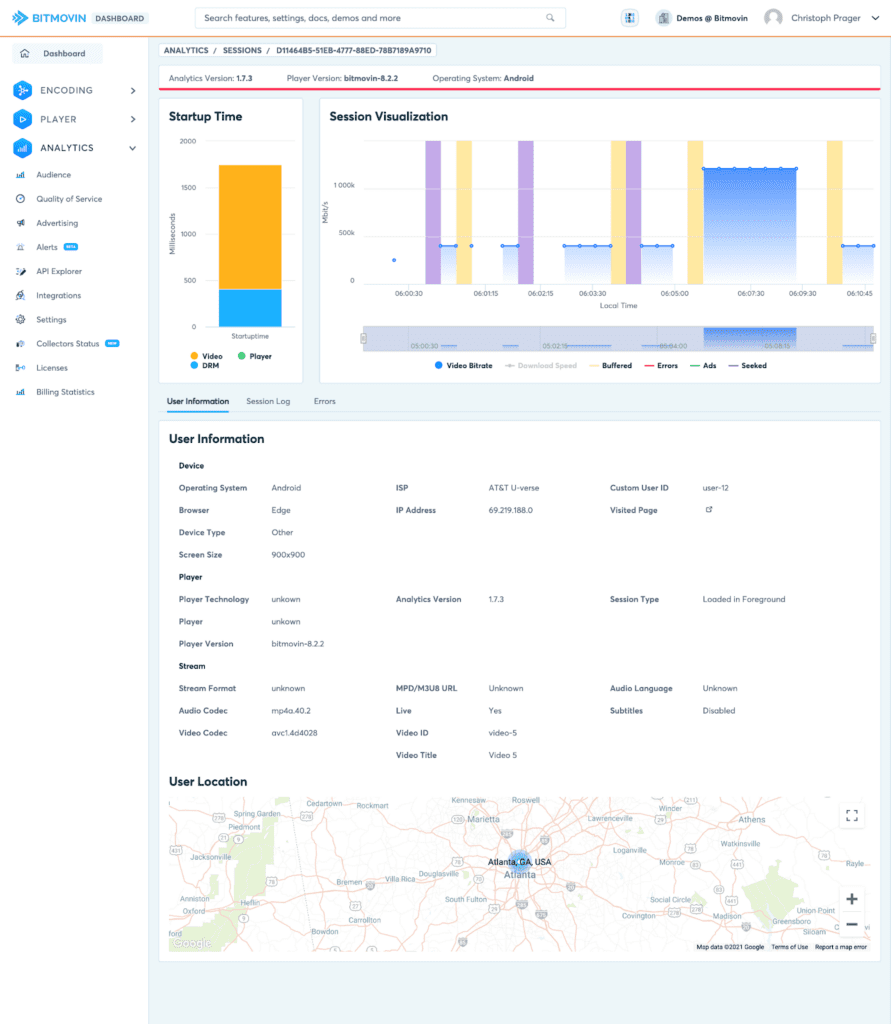
We’re currently living in the golden age of information, data, and analytics, but I don’t necessarily need to tell you that. The caveat of living in a golden age of anything is that there often is an over-abundance of a certain resource – in the case of our audience and customers, that’s video data. And when there is an over-abundance of resources, most people will reach for the lowest hanging fruit for their needs. For video, the majority of video developers (or people and organizations in OTT/streaming space), that means Google Analytics. According to Bitmovin’s Video Developer Report 2020/21, over 50% of respondents indicated that they use Google Analytics as a tool to track their Online Video Analytics.

While GA is a really great tool for tracking general website traffic such as SEO, Google Ads, visits, and more, it’s not necessarily the right tool to track online video analytics. Given that GA was built specifically for web monitoring, it’s too general and not very suitable for video analytics use-cases. Proper video analytics require a more granular data set of metrics than what GA offers. Google provides bigger picture overviews when it comes to event tracking, data aggregation, instrumentation, and even real-time data, all of which require a closer look for video analytics.
Event-based tracking
A good starting point is a concept that’s applicable across all variations of analytics, event-based tracking. However, GA is architected around collecting so-called “hits”. While a hit, as a generic event, is a good proxy to measure various behaviors, the GA version is far too general for online video analytics. In video, GA is able to simply measure frequencies via the first click (e.g. as a proxy for a play), but that’s not enough to measure the quality of experience (QoE) of a user – in this case, it tells you not whether the video successfully started after a user clicked play.
For video analytics, the play is only where the story begins, as video is a time-based medium.
To get an accurate representation of video engagement it’s important for the metrics to reflect the medium. To do so, you need more than a frequency measurement – every metric that’s duration-based has to be normalized by total session/segment length. For example, a real use comparison is around video quality via bitrate expenditure, consider the following two measurable events:
- A two-minute segment captured at 1 MBit quality
- A 30-second segment captured at 5 Mbit quality
Google Analytics will not weigh the Mbits based on the time segments and will measure the average bitrate at 3Mbit. However, when you normalize the values according to time, the average bitrate is 1.8Mbit. If you’re looking at GA, your perception is that you have a pretty good overall quality video stream, when the reality is a completely different story. This is pretty standard for Google Analytics averages, it even applies for time spent on site.
The instrumentation challenge
Now that we’ve established the importance of tracking events correctly, we can address the next issue – types of trackable video events and their origin. Tracking video events pose an additional challenge that one shouldn’t underestimate, platform consistency. Using GA or any general Analytics tool will come with the challenge of identifying and unifying events across different platforms. Since there are thousands of different devices, applications, and players, you need to be able to expose different events to hook your metrics up to. These differences need to be accounted for at any time when instrumenting and maintaining a video analytics deployment. An industry best practice is to establish a collector approach that provides data consistency across all platforms (ex: iOS, Android, web, Roku, …).
Aggregate vs. the individual
At the next level of online video analytics, it’s absolutely critical that you have the ability to monitor individual events of specific users. This granularity enables you to derive insights and hypotheses into service improvements (without even considering error or piracy monitoring). The shortfall of GA is its inherent design towards data aggregation, instead of identifying stand-out events (like errors), GA will aggregate the data to provide a holistic view of your service.
To really improve aggregate metrics you need to be able to review the behavior of a player, session-level monitoring is essential to making smart decisions around your video service.
Bitmovin’s Video Analytics applies the session-level methodology to ensure that any video service has a clear understanding of their player’s performance, providing data around Startup Time, Video Bitrate Expenditure, Device Type, Location, Stream Type, and more!

Real-time data for real-time decisions
The final shortcoming of GA is its ability to deliver data in real-time, an especially critical feature when you’re monitoring the performance of a live stream. Depending on the trackable event, GA will deliver data up to 24 hrs after its occurrence, which isn’t at all helpful when you start hearing about platform streaming issues on your Twitter feed. GA is capable of delivering information such as impressions and clicks in near real-time, but it doesn’t compare to analytics that measures performance in real-time and provide in-depth alerts that enable quick and timely reactions to any potential issues.
What you need for online video analytics
To reiterate, Google Analytics is a great base layer of analytics, especially for web and marketing metrics, but it has its limitations outside of that, especially if you’re running an OTT platform or service. To ensure that you’re delivering a top-of-the-line QoE, I’d highly recommend launching an easy-to-implement set of video analytics that measure detailed event-based data sets, can be applied for nearly every consumer device, and does it in real-time. To find out how Bitmovin’s Online Video Analytics can supplant the shortcomings of GA check out our page here, or get in touch with one of our experts.
Video technology guides and articles
- Back to Basics: Guide to the HTML5 Video Tag
- What is a VoD Platform?A comprehensive guide to Video on Demand (VOD)
- Video Technology [2022]: Top 5 video technology trends
- HEVC vs VP9: Modern codecs comparison
- What is the AV1 Codec?
- Video Compression: Encoding Definition and Adaptive Bitrate
- What is adaptive bitrate streaming
- MP4 vs MKV: Battle of the Video Formats
- AVOD vs SVOD; the “fall” of SVOD and Rise of AVOD & TVOD (Video Tech Trends)
- MPEG-DASH (Dynamic Adaptive Streaming over HTTP)
- Container Formats: The 4 most common container formats and why they matter to you.
- Quality of Experience (QoE) in Video Technology [2022 Guide]




